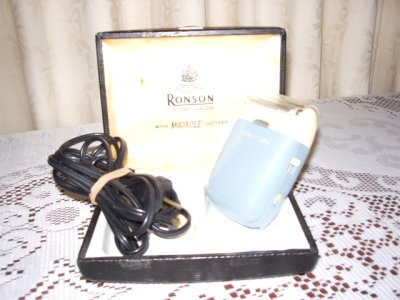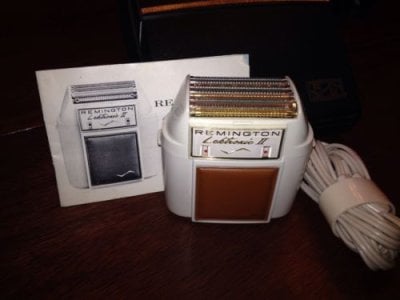Electric Shavers
By
Aubrey Razon
- Replies 0
Note from the Editor:
This article was kindly written for the SDC by member @Doctor Alan.
I’ve been using an electric shaver since puberty, and in the early days, I just used a safety razor ‘dry’. I suppose teenage whiskers aren’t so coarse, and you can get away without using all that foam and stuff we see in movies of the ‘Old West’.
I soon graduated to an electric shaver and my first shaver was a Ronson. It lasted me for years.
Later, I was probably a victim of the Remington advertising: ‘As close as a blade or your money back’.
Always being one to take advantage of technology, I bought a rechargeable electric shaver. In those days, of course, the batteries would have been nickel-cadmium, with very poor longevity and the annoying feature of building up a ‘memory’ that prevented a full charge after a while.
The charger produced 3.7v, I think, and the reason this was significant was that when we emigrated from the UK, I wanted to charge my shaver, and found that the cabin only had a 110v supply - the ship was the Achille Lauro, an Italian vessel.
I rigged up what I thought was a ‘go-around’ for charging the shaver by buying some resistors in Malta, I think. The little ‘divider’ circuit (to drop the 110v down to about 3.7v) didn’t work, though. The bloke had sold me one of the resistors with the wrong value.
Despite this, I wasn’t beaten, and found that in the corridor there was a 240v socket for their vacuum cleaners, and I was able to access my luggage in the hold and get out a nice long extension lead I happened to have brought with me. I then had the predicted visit by several concerned crew members to find out what I was up to. Happy days.
History:
The history of shaving spans from ancient times to the present, with Stone Age humans using shells and rocks to remove hair for hygiene.
Ancient Egyptians associated shaving with cleanliness and status, a practice later adopted by the Greeks and Romans, with Alexander the Great mandating it for his troops. (It has been said to prevent enemies from grabbing hair in battle.)
Over centuries, tools evolved from primitive blades to the first safety razor in the 18th century, the invention of the disposable safety razor by King Gillette in the early 1900s, and the development of electric razors by Jacob Schick in the 1930s.
Today, shaving continues to evolve with innovations in razor design (e.g., multi-blade cartridges) and the ongoing popularity of electric shavers. Wet shaving with straight razors has become more of a nostalgic, luxury experience offered at barber shops.
Types of Electric Shavers:
There are two main types of electric shavers, and I’ve flip-flopped between each one, not really finding much difference in the desired result (a close shave).
My first shaver (the Ronson) was what we now call a ‘foil’ shaver. The blades oscillate from side to side under a thin foil. The oscillation is actually quite noisy compared with the other type - the rotary shaver.
You’d think that the rotary shaver would be a less desirable prospect because of the straight edge on a foil shaver, but this has never been a stumbling block for me.
I’ve never been a slave to fashion, and having any hair at all at my age is a bonus! Besides, a straight edge along the back of my neck or side-burns can easily be achieved on a rotary shaver because they are generally fitted with a ‘pop-up’ or ‘clip-on’ edge trimmer.
Modern rechargeable shavers usually have Lithium-ion batteries that have not only a very long life with many charging cycles, but don’t suffer from the ‘memory’ problem already mentioned concerning the older Nickel Cadmium or Nickel Metal Hydride batteries.
I doubt any rechargeable shaver has anything but Lithium-ion or Lithium Polymer batteries.
(Incidentally, battery research will make the Lithium batteries obsolete in the fullness of time. Read all about which batteries your grandchildren may be using here).
Choice of shaver and parts required:
You can easily pay over $400 for what is deemed a ‘good’ shaver, such as top-end models in the Philips or Panasonic range. The ‘cleaning stations’ included with some models are probably an excellent idea, but the little fluid cassettes can be pretty costly.
Buying online has become very popular in recent times, and I’m usually a strong advocate. Still, in the case of shavers, it might be a good idea to consider the Shaver shop, Big W or K-Mart, where you can (hopefully) return them if you’re not happy with their performance.
I had to do this with a foil shaver I recently bought from Big W. It suddenly decided to turn itself on with nobody near it! It was pretty a well-known make of rotary shaver, and the company had insisted that the $25 rotary foil set was ‘unique’ to the shaver and had to be bought from them. My rebellious nature took over, and I bought a set of three rotary heads and foils for about $3.00 from Temu, and they were an exact fit, if I’d ever kept the shaver long enough to use them!
When I used the Panasonic Arc 4 shaver (supposed to be one of the best you can get, even now), I was supposed to replace the cutters and foil every 6-12 months, which would have cost over $100!
I replaced the $80 shaver I’d bought from BigW with a $20 shaver from Temu, entirely IPX6 waterproof and capable of accepting the $3.00 spare foils/heads I’d bought. It takes about 15 seconds in the morning to run the shaver under the tap and leave it to dry during the day. It also gives me the closest shave I’ve had from any shaver, including the Panasonic Arc-4 foil shaver I used to own! It has an LED countdown to tell me when to charge it and other indicators concerning foil change and washing. (A similar shaver can be found at K-Mart.)
If you worry about workmanship, don’t. Most shavers are made in China anyway. You can buy quite a few $20 shavers before you get anywhere near the cost of a so-called ‘well-known’ shaver. (Incidentally, if Temu informs you that you are ‘only $35.00 spending away from free postage’ and in so doing, tries to get you to buy other things, just try Shein, eBay or even Amazon. It might be worth paying a few dollars for postage.)
I suppose I should mention the fashion trends of ‘designer stubble’ and ‘almost bald’ head shavers, but this article is really about my own journey. You may think I’m a bit of a dinosaur in this regard, but I still like to stay ‘beardless’ and keep my hair on top as long as possible!
From the Editor:
From makeshift voltage fixes on a ship to swapping pricey shavers for $20 wonders, Dr Al’s story this week is a fun reminder that technology isn’t always about having the latest gadget… sometimes it’s about a bit of ingenuity (and a good sense of humour!).
Whether you’re a fan of old-school safety razors or the latest lithium-powered models, there’s something relatable in his tale of tinkering, trial, and triumph.
Have you ever found a clever workaround for a tech hiccup or held onto a trusty appliance that’s stood the test of time? Share your story in the comments below. We’d love to hear it!
Love Alan’s writing and want to read more? You might also like to read:
Locked Out!
Phone Woes
My Uncle Ray
Country Living
Our Best Friends
The Gambling Compulsion
Father’s Days
Being Old!
It’s About Time
The Twang’s the Thang!
Being Lucky
Are We All Liars?
The Coo of the Doves, The Hiss of the Guzunder
‘Till Death Us Do Part
Living in Retirement
Alan G.’s Member Spotlight: ‘Almost Famous’
The Ice Cream Job: The Tech Guy – Dr Al
The Lucky Man: The Tech Guy – Dr Al
‘Ten Pound Pom’ Hostel Living: The Tech Guy – Dr Al
Becoming a Better Driver by Accident!
Tech Talk with Dr Al: Accessibility Aids for the Home
Flying Round the World: The Tech Guy – Dr Al
Many Happy Returns of the Day!
Reaching for the Stars!
My great-grandfather’s journal of 1908: The Tech Guy – Dr Al
Pocket Money
University Days
Nasty Words and Silly Gestures
Up-Sticks and Move Interstate!











